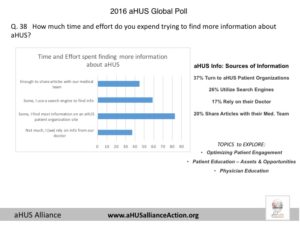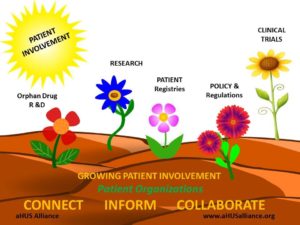
The FIRST Article in a Four Part Series
Rare Disease Advocacy: Digging deeper into Common Misperceptions
Although there are over 7000 rare diseases, rare patient populations affected by each are by definition very small numbers of people. In nations around the world, people living with a rare disease become advocates to help raise awareness, share information, offer insight, provide support, assist research, and promote healthcare policies that make a positive difference. Depending on the situation, people, and groups involved there’s both an art and a science behind effective advocacy and patient engagement in the rare disease arena. At the same time, proactive avoidance of common pitfalls to may help ideas and projects to bypass ‘echo chambers’ that fail to optimize efforts and maximize results.
The term “rare disease” might mislead the general public as an estimated 350 million people are living with one of these rare diseases, with perhaps many more people still undiagnosed or misdiagnosed. Rare disease statistics, definitions, and other information varies around the world. In Europe, a disease or disorder is defined as rare when it affects fewer than 1 in 2000 people while the USA definition is slightly different, defining a disease or disorder as rare when it affect fewer than 200,000 Americans at any given time. (Source – Rare Disease Day: What is a Rare Disease)
4 myths of Rare Disease Advocacy: A detailed look at Common Misperceptions
First of 4 articles in aHUS Alliance series
Organized groups such as national patient organizations are the only place where individual advocates can make a difference.
Rare diseases affect people all over the world, so shouldn’t advocacy approaches recognize and include patient advocates from many nations? Yet language barriers, differences in drug access and in healthcare policies, economics and resources available, and competition for funding can all affect international collaboration of rare disease advocacy groups. National rare disease groups are extremely valuable in providing information, assets, and awareness campaigns that can promote better understanding of rare disease issues. They also excel at leading broad efforts on the national stage, capable of sweeping through at state or province levels to raise awareness and encourage policies that can make a major difference to rare disease patients and their families. Given their effectiveness, it’s easy to forget that individual patients and international advocacy collaborations can contribute and enrich rare disease advocacy efforts.
Individuals can blog, post, form awareness campaigns, create artwork, fund raise, mobilize efforts in their community, and lobby their government officials. Local efforts can target small but important issues which may be so specific that they don’t gather broad interest, or are so specialized that they may get lost on a national stage. Personal networking can elevate and amplify discussion of rare disease issues, expanding awareness beyond rare disease healthcare and academic circles. A single person can create a local statement which has impact in print or video, yet remains capable of resonating on the world stage. The aHUS Alliance has compiled patient and family-created videos with its YouTube channel to showcase how unique individual patient experiences and perspectives can become even more powerful when viewed as a cohesive whole, when united as a global Atypical HUS Patient Voice.
While it’s great to see international research collaboration on the rise, global collaboration among rare disease advocacy organizations or PAGs (patient advocacy groups) has not kept pace. Research has begun to look at the effectiveness of rare disease collaboration, to include the work of Dharssi S. et al (2017) which “assesses the status of rare diseases in a sample of countries varying across economic, political, healthcare factors and, at the same time, examines the role of patient organizations in shaping national policy and programs, including rare disease legislation, national rare disease plans, and coordinated comprehensive services directed to rare diseases.” There are rare disease advocacy groups for patients in Europe, and separate ones based in the USA, but how many rare disease initiatives cross international borders? Geo-political and healthcare policies vary dramatically from nation to nation, as do resources. It’s understandable that practical matters such as travel and funding also are barriers to collaboration regarding international advocacy, but isn’t it time to acknowledge that despite differences rare disease advocates can still build on the many commonalities that exist? Everyone wants expert determination of best practices, consideration of aspects that speed acceleration of research, access and equity regarding healthcare options, and development of safe and effective therapies and devices that create better patient outcomes. It’s time to focus on what can be done – together. World Rare Disease Day, marked annually the last day of February, is a wonderful example of a joint initiative that offers opportunities for both individual people and organized groups to engage in rare disease advocacy. In actuality, for rare disease patients and their families – every day is rare disease day.
L. Burke, Dec 2017
This aHUS Alliance 4 part series will be released over four weeks, with its entirety referencing material noted below. We’ll take a closer look at these topics:
Organized groups such as national patient organizations are the only place where individual advocates can make a difference. (The Article you are Currently Reading)
The best way for rare disease patients to be an advocate is to share their personal journey and patient experiences. (Click HERE to read Part 2 of 4 topics)
Patient populations of any rare disease groups are small, so patient engagement and recruitment needs to follow particular & specific pathways to conduct surveys or to involve patients. (Click HERE to read Part 3 of 4 topics)
Patients Included: Rare disease patient advocates are invited participants at almost all healthcare and medical conferences. (Click HERE to read Part 4 of 4 topics)
THINK ABOUT: Patient Advocacy & Information Flow
Data from the 2016 aHUS Alliance Global Poll
of Atypical HUS Patients & Caregivers (N=233 respondents, from 23 nations)
How true would these insights be for other rare disease patient populations?
Survey Question 38 Sources and efforts regarding finding information about the patient’s rare disease? (Pathways and needs to consider regarding outreach & recruitment)
Atypical HUS: Sources of Information for Patients & Caregivers
37% – Turn to aHUS Patient Organizations
26% – Utilize Search Engines
17% – Rely on their Doctor
20% – Share Articles with their Medical Team

Resources & Citations
Dharssi S, Wong-Reiger D, Matthew H, and Terry S. Review of 11 national policies for rare diseases in the context of key patient needs
Orphanet J Rare Dis, Mar. 2017.
Morel T et al. Quantifying benefit-risk preferences for new medicines in rare disease patients and caregivers. Orphanet J Rare Dis, May 2016.
Robinson R. Patients and Patient Organizations Power Rare Disease Therapies. PharmaVoice.com FE 2016
Merkel et al. The partnership of patient advocacy groups and clinical investigators in the rare diseases clinical research network. Orphanet Journal of Rare Diseases May 2016
The Origins of Patients Included Patients Included: Charter
Forsythe, L et al. A Systematic Review of Approaches for Engaging Patients for Research on Rare Diseases. J Gen Intern Med. Aug 2014
Potter BK, et al. Translating rare-disease therapies into improved care for patients and families: what are the right outcomes, designs, and engagement approaches in health-systems research? Genet Med. 2016
Editioral, Vivisum Partners: corporate marketing blog Junk In, Junk Out: The Consequences of Poorly Designed Survey Instruments Apr 2014.
Utengen A et al. Patient Participation at Health Care Conferences: Engaged Patients Increase Information Flow, Expand Propagation, and Deepen Engagement in the Conversation of Tweets Compared to Physicians or Researchers. J Med Internet Res, Aug 2017

aHUS Alliance – Related Assets & Articles
Woodward L et al. An innovative and collaborative partnership between patients with rare disease and industry-supported registries: the Global aHUS Registry. Orphanet Journal of Rare Diseases, Nov 2016. 201611:154
Patients as Partners
2016 aHUS Global Poll, Results: Graphs & Insights
Patient Engagement: A reality or Merely Buzzwords
Thrombotic Microangiopathy Symposium: An Event Partnering Physicians & the aHUS Alliance Patient Organization (TMA Boston, Aug 2017)


